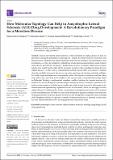Por favor, use este identificador para citar o enlazar a este item:
http://hdl.handle.net/10261/284306COMPARTIR / EXPORTAR:
 SHARE SHARE
 CORE
BASE CORE
BASE
|
|
| Visualizar otros formatos: MARC | Dublin Core | RDF | ORE | MODS | METS | DIDL | DATACITE | |

| Título: | How Molecular Topology Can Help in Amyotrophic Lateral Sclerosis (ALS) Drug Development: A Revolutionary Paradigm for a Merciless Disease |
Autor: | Gálvez-Llompart, María; Zanni, Riccardo; Garcia-Domenech, Ramon; Gálvez, Jorge | Fecha de publicación: | 14-ene-2022 | Editor: | Molecular Diversity Preservation International | Citación: | Pharmaceuticals 15(1): 94 (2022) | Resumen: | r Abstract: Even if amyotrophic lateral sclerosis is still considered an orphan disease to date, its prevalence among the population is growing fast. Despite the efforts made by researchers and pharmaceutical companies, the cryptic information related to the biological and physiological onset mechanisms, as well as the complexity in identifying specific pharmacological targets, make it almost impossible to find effective treatments. Furthermore, because of complex ethical and economic aspects, it is usually hard to find all the necessary resources when searching for drugs for new orphan diseases. In this context, computational methods, based either on receptors or ligands, share the capability to improve the success rate when searching and selecting potential candidates for further experimentation and, consequently, reduce the number of resources and time taken when delivering a new drug to the market. In the present work, a computational strategy based on Molecular Topology, a mathematical paradigm capable of relating the chemical structure of a molecule to a specific biological or pharmacological property by means of numbers, is presented. The result was the creation of a reliable and accessible tool to help during the early in silico stages in the identification and repositioning of potential hits for ALS treatment, which can also apply to other orphan diseases. Considering that further computational and experimental results will be required for the final identification of viable hits, three linear discriminant equations combined with molecular docking simulations on specific proteins involved in ALS are reported, along with virtual screening of the Drugbank database as a practical example. In this particular case, as reported, a clinical trial has been already started for one of the drugs proposed in the present study. | Versión del editor: | http://dx.doi.org/10.3390/ph15010094 | URI: | http://hdl.handle.net/10261/284306 | DOI: | 10.3390/ph15010094 | Identificadores: | doi: 10.3390/ph15010094 issn: 1424-8247 |
| Aparece en las colecciones: | (ITQ) Artículos |
Ficheros en este ítem:
| Fichero | Descripción | Tamaño | Formato | |
|---|---|---|---|---|
| How Molecular.pdf | 1,69 MB | Adobe PDF |  Visualizar/Abrir |
CORE Recommender
Page view(s)
28
checked on 24-abr-2024
Download(s)
21
checked on 24-abr-2024
Google ScholarTM
Check
Altmetric
Altmetric
Este item está licenciado bajo una Licencia Creative Commons

